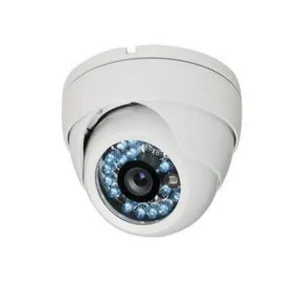
What are analog and digital CCTV, the differences, advantages, and disadvantages - Initially, CCTV was invented by Walter Brunch and was used to monitor the launch of the V-2 rocket in Germany in 1942. To this day, CCTV has continued to evolve.
CCTV stands for Closed Circuit Television, which is a computer-based video system for recording and displaying images on a monitor from the output of a camera. Essentially, CCTV is used to monitor an area that requires surveillance. Over the years, CCTV has continued to evolve, leading to the development of both analog and digital CCTV. Here is the difference between analog and digital CCTV and the definition of analog and digital CCTV itself.
What is Analog CCTV?
 |
| Analog Camera CCTV |
Analog CCTV is CCTV that uses an analog signal in its recording, which is transcribed through a DVR. CCTV DVR has quite a few types, and the supporting equipment for its installation is also more numerous than IP Camera CCTV. Although it is considered more complicated than IP Camera, the installation of Analog CCTV is still a favorite, because the recording results of Analog CCTV are more real and tend to have little delay.
Advantages of Analog CCTV
- There is a wide variety of products, ranging from cameras, DVRs to other supporting equipment.
- It does not require complicated knowledge to study it. The price is cheaper compared to IP cameras in the same class.
- The configuration is easy and the setting equipment is cheaper.
- The image quality is very good and looks real.
- The video range is further because the cable used can be further.
- The price of the DVR is cheaper.
Disadvantages of analog CCTV
- Installation of cables is heavier compared to IP cameras.
- Coaxial cable and BNC connector prices are higher.
- Requires more cables for power, data, and video.
- More prone to noise and interference.
- The equipment required for the system is more.
What is an IP Camera / Digital CCTV
 |
| IP Camera / CCTV Digital |
IP camera stands for Internet Protocol Camera, which is a type of digital video camera that sends images over a network using the Internet Protocol.
IP cameras are commonly used for surveillance, both in running a business such as monitoring store, restaurant, warehouse, and parking areas, as well as for personal use at home. IP cameras are also used in security systems, traffic monitoring, and as baby monitors. There are also various types of IP cameras on the market today, which vary in price and features.
Read Also: How to Make CCTV So That it Can be Accessed on the Internet
IP cameras can be accessed remotely from any location with an internet connection. This means you can view your home or business from anywhere at any time using a smartphone, tablet, or computer.
Advantages of IP Camera / Digital CCTV
- Installing cables is easier and simpler.
- The price of UTP and RJ45 cables is cheaper.
- It is more resistant to noise and interference.
- It is safer because it has a more secure system that can be transmitted wirelessly.
- Less equipment is needed for integration.
- This TCP/IP system will continue to evolve as technology progresses.
Disadvantages of IP Camera / Digital CCTV
- Understanding is required in order to install.
- The settings are more complex.
- The longest cable length is only 100m, the rest is less stable.
- The camera price is more expensive and the price of POE (Power Over Ethernet).
- The price of NVR is more expensive.
- Bandwidth also has an impact.
Conclusion
This is an article about the definition of analog and digital or IP cameras and the advantages and disadvantages of each CCTV. Don't forget to keep an eye on the TentangBerbagi.eu.org website for the latest information about other technologies.





